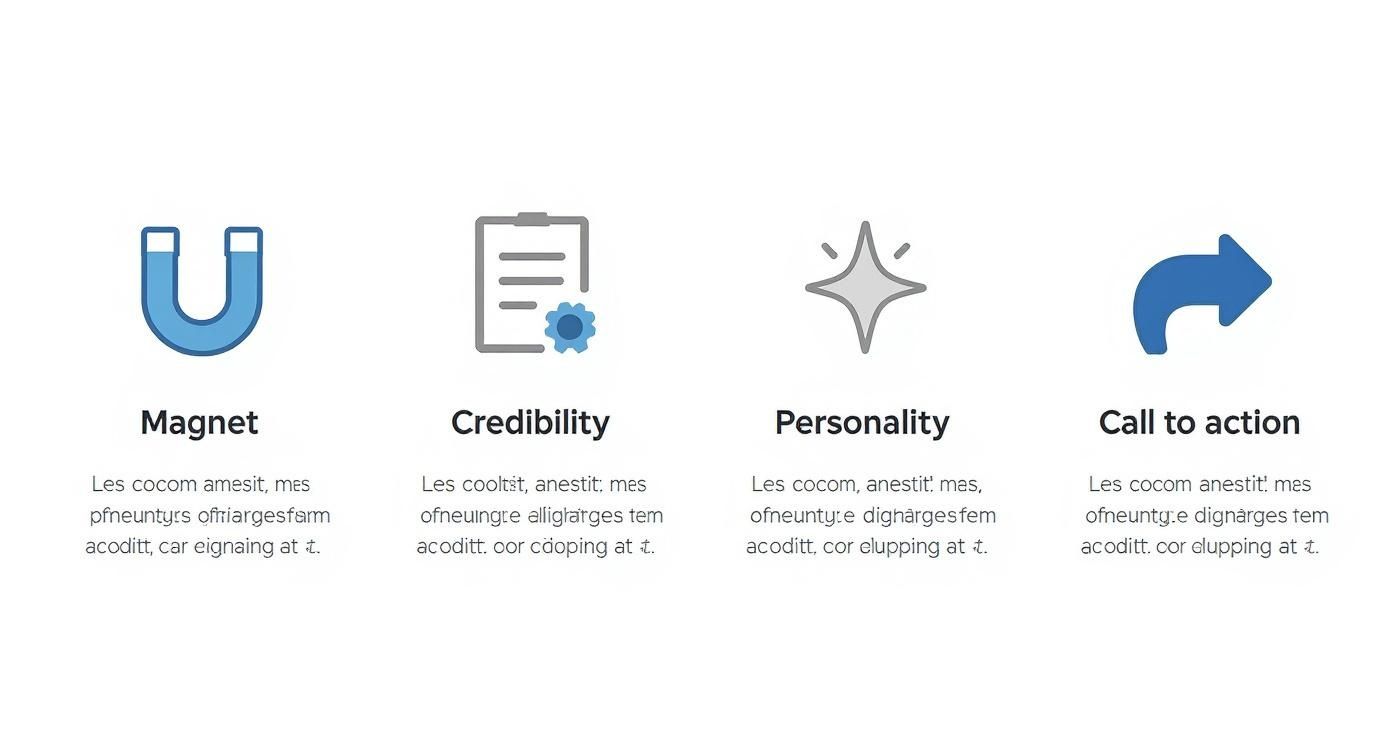Think of your author bio as your secret sales weapon. It's that little block of text on your book's back cover or at the end of a guest post, and frankly, it does more heavy lifting than most authors realize. It’s your chance to turn a casual browser into a loyal reader.
When you get it right, that short paragraph is doing three things at once:
- Building trust. It gives readers a reason to believe in you and your story.
- Establishing authority. It shows them you're the right person to be writing this book.
- Making a connection. It lets your personality shine through, making you more than just a name on the cover.
From Afterthought to Asset
Most writers treat their bio as a chore to be ticked off a list. But I want you to start seeing it differently. This isn't just a summary of your life; it's a strategic piece of marketing copy.
Every word should be chosen with a purpose: to guide the reader to their next step. That might mean buying another book, signing up for your newsletter, or following you on social media. This is where you can subtly apply powerful conversion rate optimization strategies to your writing career.
Don't just take my word for it. Data shows that bios mentioning specific, quantifiable achievements—like awards won or the number of books you've sold—can boost reader interest by as much as 20% on sites like Amazon. Specifics sell.
Your author bio isn't just a summary of your career; it's a carefully constructed narrative designed to convince someone that your book is worth their time and money. It’s the bridge between the reader’s curiosity and their commitment.
We can break down what makes a bio work into four core elements. I call them the Four Pillars. Understanding how they function together is the key to writing a bio that truly connects and converts.
Here's a quick look at these pillars to help you get started:
The Four Pillars of an Effective Author Bio
| Component | Purpose | Example Snippet |
|---|---|---|
| The Hook | Grab immediate attention and make the reader curious. | "Before writing thrillers, Jane Doe spent a decade…" |
| Credibility | Show why you're qualified to write this book. | "…is the award-winning author of ten novels, including…" |
| Personality | Make a human connection and be memorable. | "…when she isn't writing, she's usually found…" |
| Call-to-Action | Tell the reader what to do next. | "Connect with her and get a free short story at…" |
Once you’ve nailed these four components, you have a solid foundation for any author bio, whether it's a short one for your book jacket or a longer one for your website.
Of course, the short bio on your book is just one piece of the puzzle. Your website is where you can really expand your story. To dive deeper, check out our guide on how to create the perfect "About the Author" page. If you treat your bio with the same care as your manuscript, you’ll build a powerful asset that keeps working for you long after your book hits the shelves.
Tailoring Your Bio for Every Platform
One of the biggest mistakes I see authors make is writing a single bio and then plastering it everywhere. Your author bio isn't a one-size-fits-all document. Think of it like a wardrobe: you wouldn't wear a tuxedo to a picnic. The same principle applies here.
The context of where your bio appears is everything. It shapes the length, the tone, and what you choose to highlight. A snappy, 160-character bio for your X (formerly Twitter) profile has a completely different job to do than the more detailed story you tell on your author website. One needs to be a quick, memorable handshake; the other can be a deeper conversation.
Adjusting for Audience and Platform
Before you write, think about the person on the other side of the screen. What are they looking for? Someone scrolling through Amazon wants signals of credibility and a reason to believe your book is for them. A reader browsing Goodreads is part of a community and often connects with a more personal touch.
- Amazon & Retailers: This is your sales pitch. Focus on credibility—awards, bestseller status, major publications, and anything that screams "this author knows their genre." Keep it professional and laser-focused on why a reader should click "buy."
- Goodreads & Book Communities: Time to let your personality shine. What authors do you love? What quirky hobby fuels your writing? This is where you connect with fellow book lovers, not as a salesperson, but as one of them.
- Your Author Website: This is your home turf. Here, you have the space to blend both credibility and personality into a compelling narrative. It’s the perfect spot to share your full story, weaving together your professional achievements and personal journey.
Don't just copy and paste. Every platform is a fresh opportunity to connect with readers in a way that feels right for that space. Customizing your bio shows you get it—you understand the platform and you respect your reader's time.
The core ingredients of your bio—the hook, your credibility, your personality, and a call-to-action—are always there. You're just adjusting the recipe for each specific audience. This infographic is a great visual for breaking down these four essential parts.

Thinking about your bio in these four parts makes it much easier to see how you can dial each element up or down based on character limits and audience expectations.
Crafting Short, Medium, and Long Bios
To stay ahead of the game, every author should have a "bio toolkit" with three ready-to-go versions. When a podcast interview or a last-minute guest post opportunity pops up, you'll be prepared instead of scrambling to write something from scratch.
Your Three Essential Bios
| Bio Type | Typical Length | Best Used For | Key Focus |
|---|---|---|---|
| Micro Bio | 25-50 words | Social media profiles, bylines on short articles. | Your name, genre/expertise, and a link. |
| Short Bio | 100-150 words | Book jackets, guest post bios, conference programs. | A concise blend of credibility and personality. |
| Long Bio | 250+ words | Your website's 'About' page, press kits, media inquiries. | In-depth story, multiple credentials, personal anecdotes. |
Let's put this into practice. A thriller author’s micro bio for X might be: "Writes twisty psychological thrillers that keep you up at night. THE SHADOWS WATCH is out now." It’s direct, punchy, and does the job. For their book jacket, the short bio would build on this, maybe mentioning a past award or a compelling personal detail that connects to their writing.
Having these versions ready is a simple but powerful part of managing your author brand. For more on this, check out our guide on social media for authors. Taking the time to craft these different bios ensures you're always putting your best foot forward, no matter where you show up.
Let Your Authentic Voice and Personality Shine
Readers don't just fall in love with a story; they connect with the person who wrote it. Your author bio is your first, best chance to forge that connection, moving beyond a sterile list of accomplishments to show them the real you.
Think of it this way: the personality in your bio should be a direct reflection of your writing. If you write cozy mysteries, a warm and slightly quirky tone works wonders. On the other hand, if your world is hard sci-fi, a sharper, more analytical voice will feel right to your readers. Getting this match right builds instant trust and tells them they're in the right place.
A great way to approach this is by thinking strategically about the impression you want to make. It's a lot like understanding brand personality, but for you as an author.

Find Your Unique Angle
Your background, hobbies, and quirks aren't just random facts—they're the hooks that make you memorable. What parts of your story are uniquely yours? Maybe you were a marine biologist before penning sea-faring adventures. Perhaps you collect antique maps that fuel your fantasy worlds.
These are the details that stick. A reader might forget a list of literary awards, but they'll absolutely remember the thriller author who's also a competitive beekeeper.
Here are a few ways to unearth those compelling details:
- Link Hobbies to Your Writing: How do your passions and interests weave into the themes of your books? Draw that line for the reader.
- Share Your "Why": Give a small glimpse into what drives you to write in your genre or what sparked the idea for your latest book.
- Embrace Relatable Tidbits: Mentioning your love for a good cup of coffee or your hopelessly messy desk makes you human. It makes you approachable.
This isn't about spilling your entire life story. It’s about being selective and sharing the details that build a bridge between your world and your reader's. It's all part of discovering your unique authorial voice; you can explore more about that here: https://barkerbooks.com/what-is-voice-in-writing/.
Weave in What Matters to You
More and more, readers are looking for authors whose values align with their own. Your bio is a fantastic, if subtle, place to signal what you stand for. You don't need a soapbox, but a single, well-chosen phrase can say everything.
For instance, mentioning that you volunteer for an environmental non-profit or that your writing often explores themes of social justice can attract a fiercely loyal audience. This reflects a major shift in what readers look for—it's not just about a great story, but about connecting with a creator who has a meaningful perspective on the world.
A bio without personality is just a resume. A bio with personality is an invitation to connect. It tells the reader, "If you liked the book, you'll probably like the person who wrote it, too."
At the end of the day, it all comes down to authenticity. Don't try to manufacture a persona you think will sell books. Dig into what makes you genuinely interesting and share that openly. That’s how you turn a one-time buyer into a lifelong fan.
What to Include and Common Mistakes to Avoid
Let's get down to the brass tacks of building your bio. Think of it less like writing a resume and more like a firm, confident handshake. You want it to be memorable, professional, and genuine—a balancing act that even seasoned authors sometimes struggle with.
The good news is that every great bio is built on the same handful of core components. Once you know what they are, you can assemble them in different ways for different platforms. At the very least, you always need to cover who you are, what you write, and why you’re the one to write it.
The Non-Negotiable Elements
No matter how short or long your bio is, it needs a few key pillars to stand on. These are the details readers are actively looking for when they’re deciding whether to invest their time (and money) in your work. Leave one out, and the whole thing can feel a bit shaky.
Here’s what you absolutely must include:
- Your Name and Genre: Start strong and clear. "Jane Doe writes historical fiction…" This immediately sets the reader's expectations.
- Key Credentials: This is where you establish your authority. Mention your most impressive and relevant achievements—a bestseller status, a major award, or professional experience that informs your writing.
- A Touch of Personality: Give readers a hook to remember you by. A quick, interesting detail about a hobby, where you live, or a unique life experience makes you more than just a name on a cover.
- A Call to Action (CTA): This is non-negotiable for building your author platform. Tell the reader exactly what to do next. Point them to your website, invite them to join your newsletter, or ask them to follow you on social media.
These pieces fit together to paint a full picture: who you are, why you’re qualified, what makes you relatable, and how readers can find more of your work.
An author bio without a call to action is like a great conversation that ends abruptly. You've hooked them—now give them a place to go.
Common Mistakes That Weaken Your Bio
Knowing what not to do is just as important as knowing what to include. A few common missteps can instantly undermine your credibility or create a weird disconnect with your audience. The great part is, once you can spot them, they’re easy to fix.
The First-Person vs. Third-Person Puzzle
One of the most common trip-ups is choosing the wrong point of view. Writing in the first person ("I write…") feels natural, but it can come across as unprofessional in certain contexts. The third-person voice ("She writes…") is the industry standard for book jackets, press releases, and formal guest posts.
So, when should you use which? Here’s a quick guide to help you decide.
Choosing Between First and Third Person
| Platform or Context | Recommended Point of View | Why It Works Best |
|---|---|---|
| Book Jackets & Retail Sites | Third Person | Creates a professional, authoritative distance. It's the industry standard. |
| Your Author Website "About" Page | First Person | Feels more personal and direct, helping you connect with your readers. |
| Social Media Profiles | First Person | Keeps the tone conversational and authentic, which is what these platforms are for. |
| Press Releases & Media Kits | Third Person | Provides journalists with ready-to-use, professional copy. |
| Guest Blog Posts | Third Person | Typically required by publications for consistency and a professional tone. |
Ultimately, the goal is to match the expectations of the platform. When in doubt, third-person is almost always a safe bet for professional contexts.
The Credibility Conundrum
Next up is the delicate dance of credibility—sounding either too boastful or too timid. It’s a tough line to walk. Listing every single short story prize you won a decade ago can feel a little desperate. On the other hand, being too modest and hiding your big wins does you a huge disservice.
The solution is to be selective and confident. Pick your one or two most powerful achievements and state them simply.
The Outdated Bio
Finally, we have the most forgivable but still damaging mistake: a stale bio. If your bio still mentions your "upcoming" novel from three years ago, it sends a clear signal that you aren't actively managing your author presence.
Make it a habit to review your bios at least twice a year. And definitely give them a refresh after any major career milestone, like publishing a new book or winning an award.
Optimizing Your Bio for the Digital Age
Think of your author bio as more than just a static paragraph on a book jacket. In the online world, it's your digital handshake—a critical tool that helps readers find you in a very crowded room. A well-crafted bio acts like a signpost, guiding potential fans straight to your work.
This means you need to start thinking about search engine optimization (SEO) right from the get-go. The key is to weave in keywords that feel completely natural. For example, if you write "historical romance set in Regency England," you'll want that phrase, or something very close to it, right there in your bio. Readers are constantly searching for specific genres on Google and Amazon, and using those terms is how they’ll stumble upon you.

Beyond Static Text
Let's be honest, today's readers want a connection. A flat block of text just doesn't cut it anymore. Your bio needs to be an interactive hub, a starting point for readers who want to know more about you and your work. The modern author bio links out to social media, personal websites, and blogs, helping authors build a real community and a solid digital presence. If you're curious, you can learn more about how authors use bios to build their brands.
This is your chance to turn your bio into a gateway. Don't just list your accomplishments; give people clear, easy ways to continue the journey with you.
- Link to Your Author Website: This is your home base. Your website should be the number one link, where readers can find everything from your complete book list to your latest blog post.
- Direct to Your Newsletter: The most direct line you have to your readers is their inbox. Offer a little something—a free short story or a chapter preview—to get them to sign up.
- Connect on Social Media: Pick one or two platforms where you're genuinely active and engaged. Don't throw five different links at them; it's overwhelming. Guide them to where the real conversation is happening.
Think of your bio as the beginning of a conversation, not the end. Every link is an invitation to learn more, connect on a deeper level, and become part of your author community. It’s your chance to turn a one-time reader into a lifelong fan.
Telling a Compelling Brand Story
When you get right down to it, optimizing your bio is all about storytelling. I’m not just talking about the stories in your books, but the story about you. Every piece of it, from the keywords you sprinkle in to the links you provide, helps build your author brand. It tells readers who you are, what you care about, and why they should spend their precious time in the world you've created.
Authenticity is your best tool here. Give them a glimpse into your writing process, what inspires you, or a quirky personal detail that connects to your genre. That human touch is what makes your brand stick in a reader's mind and builds a genuine connection that will have them coming back for your next book.
Answering Your Trickiest Author Bio Questions
You've got the basics down, but what about those nagging little questions that pop up right when you think you’re finished? It happens to every writer. Here are the answers to the questions I hear most often from authors struggling to get their bio just right.
"How often should I update this thing?"
Think of your author bio as a living document. It's not something you write once and forget about. I tell my clients to give it a quick review at least once a year, but you need to update it immediately after any big career news. Nothing looks worse than a bio that’s obviously out of date—it can make you seem like you're not paying attention to your own career.
Be ready to refresh your bio the moment you:
- Publish a new book
- Land on a bestseller list (even for a day!)
- Win an award or even get shortlisted for one
- Get a major media mention or a killer endorsement
Keeping it current shows agents, editors, and readers that you're an active, professional author.
A fresh bio signals you’re engaged in your career. An old one suggests you’ve checked out. Give it the same attention you give your manuscript.
"What if I'm a new author with nothing to show yet?"
This is probably the most common fear I hear, and it’s much easier to handle than you think. An author bio is all about building credibility and connection, and a long list of publications is only one way to get there. Don't focus on what you don't have. Instead, highlight what makes you the only person who could have written this specific book.
Lean into your unique angle:
- Relevant Life Experience: If you’re writing a crime thriller and used to be a paramedic, that’s gold. Put it in.
- Your Background: A degree in marine biology is a huge asset for a book about deep-sea exploration.
- Your "Why": What’s the spark that led you to this story? A brief, passionate mention of your inspiration can be incredibly compelling.
Your job is to build a bridge of trust with the reader, and your life experience is the foundation.
"Can I be funny in my bio?"
Absolutely! But—and this is a big but—only if it fits your author brand and the genre you write in. Humor can be a fantastic way to connect with readers if you write things like romantic comedies, cozy mysteries, or witty nonfiction. It gives them a taste of your voice before they even open the book.
On the other hand, a wisecrack in the bio for your gut-wrenching literary drama or a stark political thriller will feel completely out of place. Let your writing style be your guide. If you’re on the fence, run it by a beta reader and ask them, "Does this feel like me?"
"Should my bio be different for fiction vs. nonfiction?"
Yes, definitely. The core elements are the same, but the emphasis shifts depending on what your reader is looking for. It all comes down to the question you’re trying to answer for them.
| Genre | Your Main Focus | The Reader's Unspoken Question |
|---|---|---|
| Nonfiction | Expertise & Authority | "Why is this person qualified to teach me about this?" |
| Fiction | Personality & Storytelling | "Is this an author whose stories I'll get lost in?" |
For a nonfiction bio, your credentials, professional background, and anything that screams "expert" need to be front and center. For fiction, you have a lot more room to play. You can share a quirky hobby, reveal a bit of your personality, and let that unique storytelling voice come through loud and clear.
At BarkerBooks, we help authors navigate every part of the publishing maze—from polishing a first draft to writing a bio that opens doors. If you're ready to see your story become a professionally published book, we're here to help. Explore our author services today.
